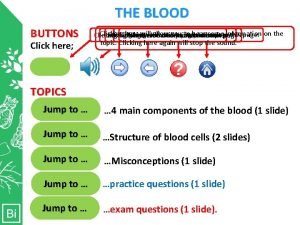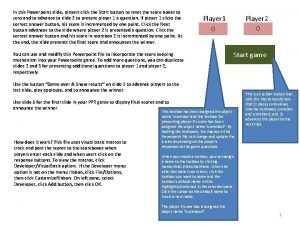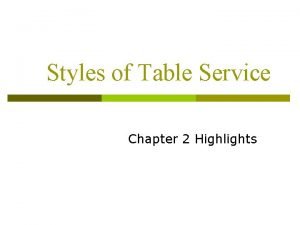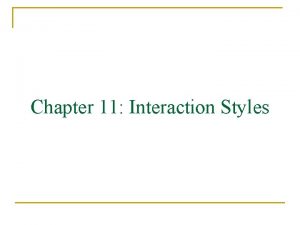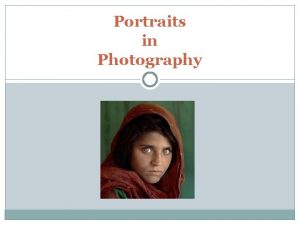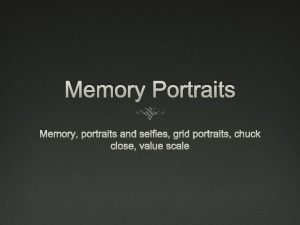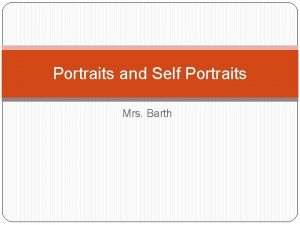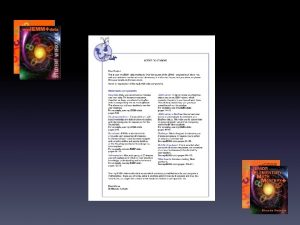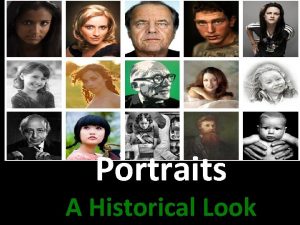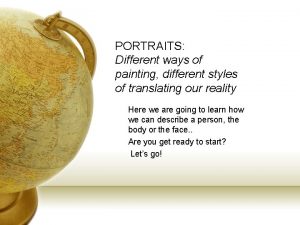portraits portraits Different forms and styles CLICK HERE








![Self portraiture - post modern [the artist placing themself in different contexts/artists] Cindy Sherman Self portraiture - post modern [the artist placing themself in different contexts/artists] Cindy Sherman](https://slidetodoc.com/presentation_image_h/2cfb29ef0a9194d273a253cdfe450534/image-9.jpg)






- Slides: 15

portraits portraits

Different forms and styles CLICK HERE There is no single definition of a portrait. In Australia, after white settlement, the earlier portraits were intended to provide a recognisable likeness of the sitter and project a heightened image of the person or subject. They were also expected to reflect something of the social status and wealth of the sitter. Such tradition was drawn from the work and writings of academic artists of nineteenth century Britain [ Thomas Gainsborough and Sir Joseph Reynolds]. As the founder of the British Royal Academy, Reynolds was able to establish a type of formula formal portraiture which has continued into the twentieth century. Find an example of an academic portrait in our school [meaning the style set down by members of the academy and tend to be formal with dark backgrounds] A more contemporary view of the purpose and function of portraiture comes from art writer Nevill Drury, who argues that Ideally, portraits should provide us with authentic insights into individual personalities and this means much more that simply recording physical impressions … the task of the portrait artist is not so much to produce a likeness as to capture the ‘reality’ of a person. Most people agree the portrait includes a depiction of a face. The degree to which its features are captrued realistically or distorted by the artistfor interpretive purposes has always been a matter for debate.

“The face, in the final analysis, is the expression …. Something like an equation by which we show our relationship with others. It’s a roadway between oneself and others” Japanese poet Kobo Abe

“The portrait I do best is of the man I know best” Nadar “Every person’s story is written plainly on his face” August Sander

Different forms and styles The way in which artists frame, position or pose their sitter can vary greatly. The sitter can be shown at full length, three-quarter length, waist length, head and shoulders or even a part of the face. Portraits can vary in the position of the sitter. They may face the viewer, be at three quarter view or be a profile. The distance from which the artist views the subject can also differ ……. From a closer, conversational distance to a super close, super real distance. And the viewpoint can also differ from a low viewpoint to make the sitter look monumental [ like so many Reifenstahl images of Hitler] to a high viewpoint which may make the sitter appear small and perhaps vulnerable. The sitter may look straight at the viewer or off to the distance to somewhere outside the canvas. When analysing a portrait it can help to put your own body in the sitter’s position, a slight upward tilt of the jaw may suggest arrogance, slump of the shoulders, weariness, and a tilt of the head may suggest curiosity. Some artists even challenge the very conventions of portraiture by incorporating words to suggest thoughts for instance or by collecting found objects from a person’s life.

Different purposes of portraiture The concept of portraits probably began in the ancient Egyptian times when likenesses were created to convey the dead for the after life. In Ancient Rome death masks were made and faces began to be seen on coins. Generally, the main purposes of a portrait are 1 to convey a likeness 2 commemorate a family or dynasty 3 portray a character, personality or type 4 commemorate achievement, or reflecting position or power 5 convey humour, satirise or caricaturing 6 portray self 7 achieve professional aims: career or prizes At the turn of the century artists’ patrons did not need to rely on portrait painters to make their momentos or keepsakes, they were able to freeze frame their own set of family images using the kodak box brownie camera Click Here for More Arnolfini

Self portraiture Three artists immediately spring to mind when considering the self portrait. This is because they consistently painted their portraits over their lifetimes and through various turmoil. They are Rembrandt, Van Gogh and Frida Kahlo was a Mexican Surrealist artist. As a child she was hit by a bus and received multiple injuries that progressively worsened. She was often confined to bed in excrutiating pain and was unable to bear children. Many of her paintings are relatively small to allow her to continue working even fromher bed. The man next to her in the photograph is Diego Rivera a famous Mexican Mural artist and Kahlo’s partner.

Self portraiture - Some of Van Gogh’s self portraits
![Self portraiture post modern the artist placing themself in different contextsartists Cindy Sherman Self portraiture - post modern [the artist placing themself in different contexts/artists] Cindy Sherman](https://slidetodoc.com/presentation_image_h/2cfb29ef0a9194d273a253cdfe450534/image-9.jpg)
Self portraiture - post modern [the artist placing themself in different contexts/artists] Cindy Sherman and Yasama Morimura are artists who enjoy placing themselves within other artworks and exploring the changed meaning and the audience reactions. Viewers need to know the original reference to appreciate the artist’s intention. Can you identify the original reference artist or genre for thesepaintings?

Analysing a portrait When discussing a portrait ensure you have considered 1. How the figure is placed within the frame and how this adds meaning 2. How hands are placed, feet. Head angle, eye contact [or not], where the viewer is [below, above or at equal height]. Is the figure facing you, looking back over a shoulder, peering through something etc. This adds meaning 3 Props …. One of the headmaster portraits at school has the sitter holding a heavy book and wearing academic robes which all identify the sitter’s occupation. What is the sitter wearing, what’s in the background, what objects are visible …. . Carefully look through the painting for clues. An artist will not put into a portrait painting anything that’s irrelevant 4 The painting’s style and qualities such as colour are also important and express ideas the artist may have about the sitter’s personality. Are the brushstrokes expressive, are the colours moody/unrealistic, are there strong shadows or strong light. Is there any distorion? Consider the way the artist has painted the subject and the choices they have made. 5 When was the artwork painted? What do we CLICKHERE

FRANCIS BACON Of course one knows how very potent some of the images of Christianity have been and how they have played very deeply on one’s sensibility. And after all, one believes in the ethics of Christianity, or a great number of them, without actually believing in the practice of the Church. Francis Bacon 1966 A brief analysis Notes on how to analyse a portrait Study After Velasquez’s Portrait of Pope Innocent X, 1953

BIOGRAPHICAL DETAILS Born 28 th October 1909 in Dublin. Died 1992. Francis Bacon came to London in 1925 and although he received no formal art training, he created a sensation in 1945 when he exhibited his Three studies of the Crucifixion (London, Tate Gallery) at the Lefevre Gallery in London. His work was Expressionist in style, and his distorted human forms were unsettling. He developed his personal style and gloomy subject matter during the 1950 s, when he achieved an international reputation. Aside from his unpleasant images of corrupt and disgusting humanity, Bacon deliberately subverted artistic conventions by using the triptych format of Renaissance altarpieces to show the evils of man, rather than the virtues of Christ. In Pope Innocent X he reworked a famous portrait by Valasquez into a screaming mask of angst. "

CLICK ON IMAGE FOR MORE VELAZQUEZ

Critical Writings BACK Home Those heavy vertical lines resemble iron bars. These do not combine with the snarl, as they might have done, to create a banal illustration of a wild beast behind the bars of its cage. They are active, seeming to shuttle from side to side so that the spaces between them expand contract, hemming the figure in, cramping it, and making us feel in our shoulders that we ourselves are held in, captive, unable to escape from an eyeball confrontation with that awesome face. David Sylvester 2000. Looking back at Francis Bacon. Thames and Hudson.

Ninety-five per cent of people are absolute fools, and they’re bigger fools about painting than anything else…. Hardly anyone really feels about painting; they read things into it - even the most intelligent people - they think they understand it, but very few people are aesthetically touched by painting. Francis Bacon
 Click clever
Click clever Cyber safety
Cyber safety Click clever click safe
Click clever click safe Click clever click safe
Click clever click safe Click here to add text
Click here to add text Click here buttons
Click here buttons Click here for instructions
Click here for instructions Your score: 1 click here to start playing
Your score: 1 click here to start playing Hello in lithuanian
Hello in lithuanian Click here to start playing
Click here to start playing Click here to download
Click here to download What are the characteristics of contemporary
What are the characteristics of contemporary Table service types
Table service types Different styles of greenhouses
Different styles of greenhouses Menu selection interaction styles
Menu selection interaction styles Different influencing styles
Different influencing styles





